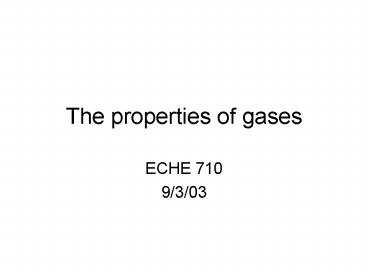The properties of gases - PowerPoint PPT Presentation
1 / 34
Title:
The properties of gases
Description:
Calculated PV isotherms of CO2. V. Der Waals. RK. Subcritical isotherm. GADL experimental curve; areas of the loop below and above DL are equal. ... – PowerPoint PPT presentation
Number of Views:53
Avg rating:3.0/5.0
Title: The properties of gases
1
The properties of gases
- ECHE 710
- 9/3/03
2
Ideal gas equation of state
3
Extensive and intensive properties
- Volume
- Mass
- Energy
- Enthalpy
- Entropy
- Temperature
- Pressure
- Chemical potential
- Molar volume
- Molar entropy
4
Properties of ideal gases
T -gt 0 as v-gt 0 T lim (P-gt0) Pv/R
Pv 22.414 L.atm as P-gt0 H2 (g) crosses N2 (g)
diamonds CO2 (g) circles T 273.15 K
5
The compressibility factor
300 K
methane
6
Compressibility factor, Z
- At low T ? attractive forces are dominant, vreal
lt videal ? Pv/RT lt1 ? Z lt 1 - At high temperatures, molecules have high kinetic
energies, repulsive forces are dominant, ? vreal
gt videal ? Pv/RT gt1 - ? Z gt 1
7
The van der Waals EOS
- Is an extension of the ideal gas EOS to account
for intermolecular interactions. - What happens when v-gt8?
- a gt attractive forces
- b gt molecular size
8
Z from van der Waals
9
The Redlich-Kwong EOS
10
The Peng-Robinson EOS
a is a function of temperature
Ethane, 400K Experimental (solid) V der Waals
(dot-dashed) RK (long-dashed) PR (short-dashed)
11
A cubic EOS can describe the Liquid and Vapor
phases
Experimental P-V isotherms CO2, Tc 30.99 oC
12
Calculated PV isotherms of CO2
RK
V. Der Waals
13
Subcritical isotherm
- GADL experimental curve areas of the loop below
and above DL are equal. - AB metastable (SH vapor) CD (SC liquid)
- BC unstable (dp/dv) gt0
- Cubic eqn.
14
Conditions at the critical point
- Can be solved to obtain a and b in terms of Tc,
Pc, and vc - vc3b
- Pc a/(27b2)
- Tc 8a/(27bR)
15
The critical compressibility factor, Zc
- From van der Waals
- Pcvc/(RTc) Zc 0.375
- From Redlich-Kwong
- Pcvc/(RTc) Zc 0.33333
- From Peng-Robinson
- Pcvc/(RTc) Zc 0.30740
- gt Zc constant gt should be the same for all
substances (see Table 2.5)
16
Law of corresponding states
17
Law of corresponding states
It is a universal equation, for all substances.
18
Virial equation of state
What are the limits as v -gt 8 and as P -gt 0 ? See
Table 2.6
19
Second virial coefficients
- Experimentally from the slope of Z vs. P
- T-dependence
- Boyle temperature gt B2v(T) 0, repulsive and
attractive interactions cancel each other.
20
Pair interactions between molecules
- For non polar molecules, U(r) is a good
approximation.
u(r) 0 far all r, what is B2v?
21
General form of u(r), nonpolar molecules
- u(r) -gt -c6/r6 ? attractive forces
- u(r) -gt cn/rn ? repulsive forces
- (n 12)
- The Lennard-Jones potential
22
The LJ 12-6 potential
- B2v(T) can be calculated numerically from the LJ
potential
23
Law of corresponding states
- Defining T kBT/e and x r/s
24
Reduced 2nd virial coefficient
When P is sufficiently small to neglect the 3rd
virial coefficient
25
Short-range attractive interactions
- Permanent dipoles
- Induced dipoles
- Instantaneous dipole-dipole interaction (London
attraction)
26
Dipole-dipole interactions
Permanent dipole-permanent dipole
Induced dipole (See table 2.8)
27
Dipole-induced dipole interactions
This interaction is always attractive
28
London dispersion forces
- Interactions of electron clouds that generate
instantaneous dipoles
29
Total (short-range) attractive forces
- C6 udipole-dipole uinduced udispersion
30
Simpler intermolecular potentials
- Hard sphere (a) and Square-well (b) potentials
31
2nd virial coeff. for the HS potential
32
2nd virial coeff. for the square-well potential
- Nitrogen, calculated, exp. points (circles)
33
2nd virial coeff. for cubic EOS
34
HW 2 (due Monday, Sept. 8)
- PROBLEMS
- 2.8 2.13 2.15 2.20
- 2.24 2.25 2.29 2.33
- 2.46 2.47 2.58 2.59































